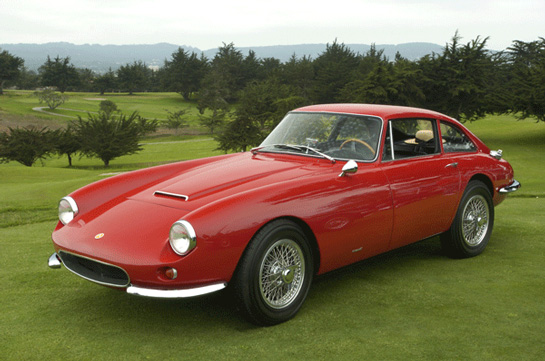
The original lines for the Apollo were penned by Art Center graduate Ron Plescia. Il Maestro Franco Scaglione was called in to smooth out the details and prepare the body for production. Harold Pace photo
By Robb Northrup
Northrup is the president of the Apollo Owners Registry. Readers interested in the Apollo can suscribe to the group’s (somewhat) quarterly free e-newsletter by contacting apolloregistry@yahoo.com
The Apollo GT was one of the best marriages of Italian style with American muscle and reliability. Yet, many enthusiasts are unaware of this Ferrari contender, 88 examples of which were built by hand in Italy and assembled in Oakland, California during 1963-65.
In 1960, a trio of Northern California twenty-somethings saw that imported sports cars had a major deficiency: while they were admired by enthusiasts for their exotic styling and hot performance (especially the Italians), imported sports cars had also developed a nasty reputation for being less than trustworthy.
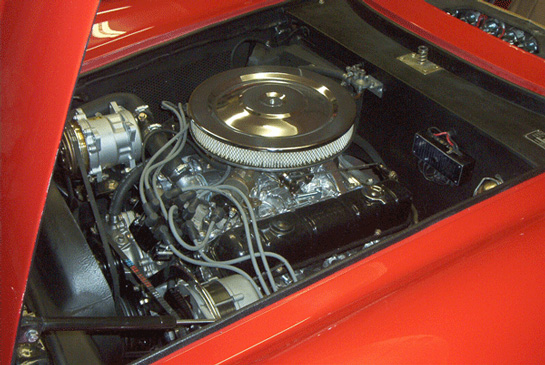
The reliable Buick aluminum V8, rated at 200-250 hp – provided plenty of grunt and for a 2400 lb. car. And torque that would outdrag a Ferrari 250. Mike Anderson photo
Indeed, it was a very brave man who dared to drive his Jaguar or Alfa Romeo too far from home; it might break down at the worst possible moment. And with few dealers and repair shops available, a cross-county trip was a challenge.
Commuting to work was also a questionable activity, as anyone who’s seen an old Jag in five o’clock traffic can attest to. And if it was a Ferrari? Never.
So, Milt Brown, Ron Plescia, and Ned Davis combined their resources to create a fast, powerful gran turismo in the tradition and style of Ferrari and Maserati, but with the room, reliability, and serviceability of a Buick.
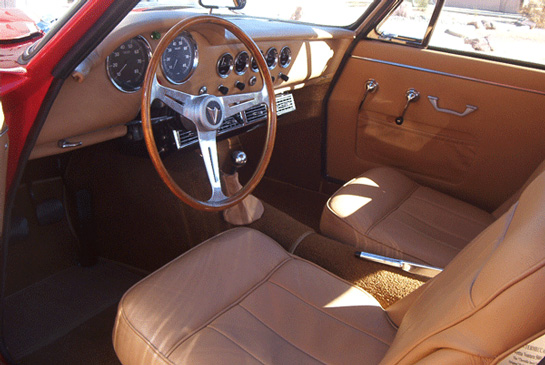
The interior was a combination of wool carpet, vinyl door panels and dash, and leather seats. The dash has that Italian “artisan” look characteristic of low-volume coachbuilt products. This is one of the Texas-built cars. Mike Anderson photo
In high school, Brown and Plescia had already designed dozens of such cars (when they should have been studying!). After college, Brown took his enthusiasm to Europe where he worked as an engineer for Emeryson, a small race car builder in England. There he gained valuable experience designing chassis and suspensions. During his free time, he searched for a possible coachbuilder for this Euro-American grand touring car.
Back in the States, Ron Plescia, newly matriculated from the prestigious Art Center of Pasadena, was already honing his skills as a product designer.
Partner number three, Ned Davis, held a business degree from the University of California at Berkeley and had his hand in a number of small enterprises. As a small business owner, Davis learned all about cash flow management and promotion – with limited budgets, he had to do it all himself. This would come in handy as the project progressed.
While in Europe, Brown by chance met Frank Reisner, an engineer and owner of the coach building firm Carrozzeria Intermeccanica in Torino, Italy. While Brown found other such suppliers to be frightfully expensive to build a prototype ($50,000 or more – about $350,000 in 2010 dollars), he discovered Reisner could do the job for a mere five grand. Striking a partnership with Reisner with just a handshake, Brown returned from Europe in the Fall of 1960 to begin serious work on a new Italian-American GT.
In two weeks, Plescia drew a curvaceous body reminiscent of the Ferrari 250 Speciale, with a hint of Jaguar E-Type (“We wanted a car with Italian styling but with E-Type proportions,” recalls Brown.) and hand molded a 1/4 scale fiberglass model from which Reisner would construct a prototype.
Meanwhile, Brown found an outstanding American car upon which to base this GT: the 1961 Buick Special, a Detroit compact that offered a really advanced suspension for its day. While Ferrari and Maserati still used leaf springs on a live rear axle, the Special utilized a very sophisticated four-link trailing arm suspension – with coil springs – on a live axle. The unit was not only lighter, but offered better handling. The front control arms were nicely attached via bronze bushings, an advanced Buick touch.
Brown tied the whole package together with a very simple – yet light-and-strong – ladder frame.
For motivation, the Special’s new 215 cubic-inch aluminum V8 was not only European in specification (3.5 liters and only 318 lbs. dry) but also powerful: 200 b.h.p. as supplied by GM; 225 when tweaked by Brown. Coupled with the silky smooth Borg Warner T-10 four-speed gearbox, the new car had plenty of go. Early literature (written and produced by Ned Davis) claimed acceleration times of 0-60 in 7.5 seconds and a standing start quarter mile in 15.6 seconds. Top speed could reach 140 with the optional 3:08 rear axle. Very competitive performance.
It was Ned Davis who supplied the $5,000 to pay for the prototype. The trio shipped Brown’s new chassis, along with Davis’ money, to Intermeccanica in December, 1961. In August the following year, the aluminum bodied prototype arrived in Oakland, and Brown and Davis readied it for its debut at Bev Spencer Buick in San Francisco. The public’s reaction was so favorable that Brown, Davis, and Plescia decided to go ahead with production and incorporated as International Motor Cars of Oakland. But the new company was woefully undercapitalized with only $21,000 in the bank, the funds donated by family members and friends. “We knew it wasn’t enough,” recalls Ned Davis. “But we thought we’d get enough orders to stay in business. Besides, a chance like this only comes once in a lifetime.”
With a firm commitment for two cars per month, Frank Reisner geared up to build, paint and trim Apollo bodies in steel and called in the famed Franco Scaglione (designer of the Bertone B.A.T. show cars) to tweak the design and ready it for production. The same artisans that supplied panels and bodies to Zagato and other small carrozerrie in Torino also built bodies for Apollo, completely by hand.
With production trickling in, IMC launched the new 3500 GT in Hollywood in March, 1963 and priced the car at nearly $7,000 – between Jaguar and Ferrari, a niche where the Apollo was the only competitor.
Initial reaction from the press was extremely positive: “Workmanship is of the highest quality,” declared Hot Rod. “Panels fit well, doors close with authority, and the interiors are comparable to cars costing twice that of the Apollo.”Denise McCluggage, writing for Science and Mechanics (and a racing driver to boot) was pleasantly surprised to find “…the Apollo handles as well or better than a 2+2 Ferrari, an Aston Martin DB4, or a Sting Ray Corvette.”
But it was Road & Track (in a road test authored by Dean Batchelor) that identified the real flavor of the Apollo recipe: “During our testing, no less than eight full-throttle acceleration runs were made in the space of ½ hour, reaching 110 mph on several…To the car’s credit, the engine performed without a murmur, got nowhere near a dangerous temperature, maintained oil pressure and exhibited not a trace of clutch slippage. A lesson could be learned here by some of our noted “sports car” manufacturers…And it can be serviced…at any garage which has a capable mechanic, and parts for the running gear can be obtained at any Buick garage.”
Brown, Davis, and Plescia had achieved their goal of producing a GT combining an exotic Italian body with American reliability and power.
Sales followed at two cars per month – a brisk clip for a very low volume builder with a 6,000 mile assembly line. Among early buyers were entertainers Pat Boone and Larry Ramos (of the singing group The Association). And professionals and doctors also bought Apollos because they could finally drive their exotic car to the office.
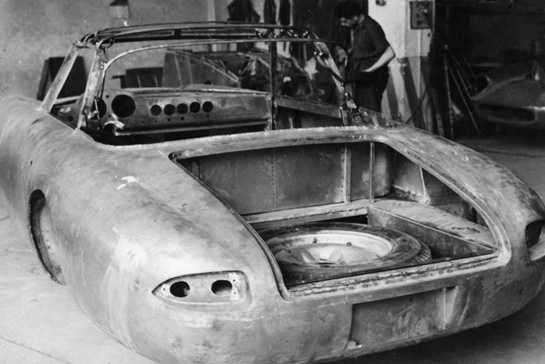
This is the first convertible – no. 2001 – under construction in Turin, Italy. The back half is all Scaglione’s work, and it remains an unrecognized masterpiece. Former company sales manager George Finley is now the owner. Milt Brown photo
More power and performance came with the introduction of Buick’s 300 cu. in. V8 (5,000 cc), making the Apollo as quick as contemporary Ferraris. The car’s blistering performance was proven in 1996 when journalist Winston Goodfellow, performing a road test of an Apollo 5000 GT for a British magazine; his impromptu race with a mid-year Stingray while driving a 215-powered convertible revealed that the smaller-engined car was no slouch, either.
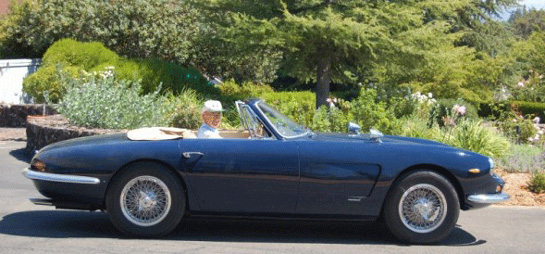
Here’s proof of the convertible’s pudding. An elegant and exotic shape. Who’d ever guess there’s Buick under the skin. Jack Triplett photo
Indeed, my own experience driving three Apollos confirms the excellent handling and road holding praised by journalists of the day. In fact, driving back from California’s Big Sur (on Highway One!) in Jack Triplett’s spyder revealed that on a decent road, you’d never know the Apollo used a live axle. And when driving the second-to-last-coupe built – once owned by Milt Brown himself – I found that my seat-of-the-pants timing confirmed that the five-liter version was every bit as quick (or faster than) as contemporary Ferraris and Vettes, while Masers and Jags paled in comparison…
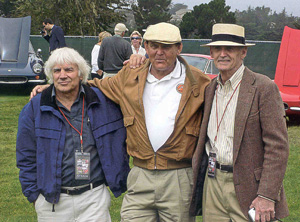
Davis (left), Brown and Plescia at Monterey, 2006. Photo credit James Taylor From the book Intermeccanica, The Story of the Prancing Bull.
A total of 88 Apollos (including one 2+2 and eleven
Spyders) were built during a two year run. “It was a winner because we could never make enough to satisfy the demand,” laments Brown. “We should have stayed small and charged more for out product.”
A sad ending, perhaps, but not the last word. Disney used an Apollo as the “Thorndyke Special” in the original Love Bug movie in 1969. A decade later, the Apollo was given milestone status by the Milestone Car Society.
And today, with over 50 cars identified with owners, every Apollo is highly coveted.
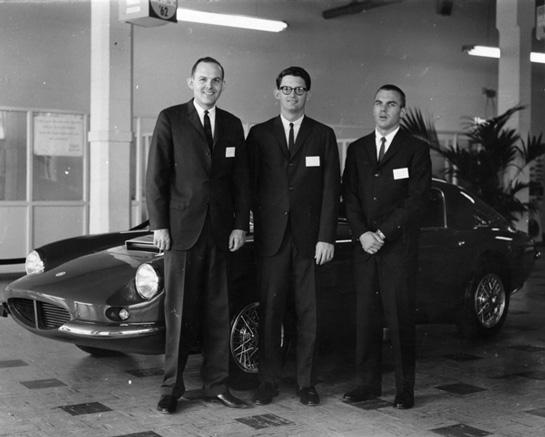
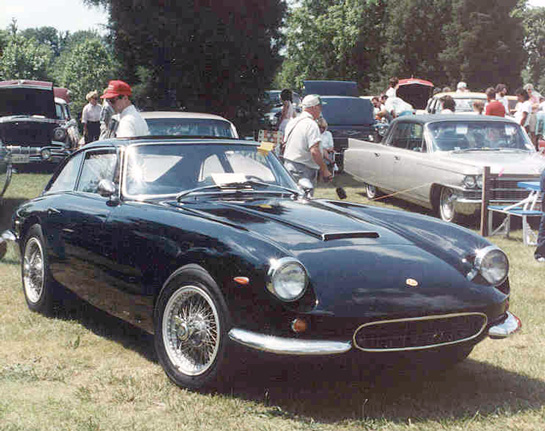
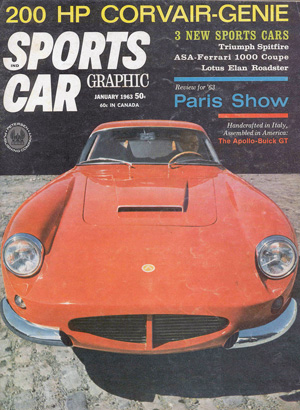
If anyone knows about an Apollo for sale, please do let me know.
I can be contacted at : alexfreda@hol.gr
It has to be a very good car though…
I like to read about the Apollo. I read somewhere that Milt Brown had several at his house in the Oakland Hills when there was a raging fire that destrying over 400 homes, including his and his cars. Just when he despaired of having an Apollo again he ran across one at a gas station. I don’t remember if he bought it but I remember that he was reinvigorated by it. I’d like to know if the book discusses the mystery of Scaglione, like how he supposedly “disappeared” and people thought he had died and then reappeared on the scene years later. Also does it discuss who designed the Italian–I remember the car shape being attributed to Scaglione but then Bob Cumberford says he did it. I thought the Apollo could have outdone the Cobra but I suppose it had too narrow wheels and tires and must have weighed a lot more and then too GM wasn’t helping with the go-fast goodies like Ford was helping Shelby.